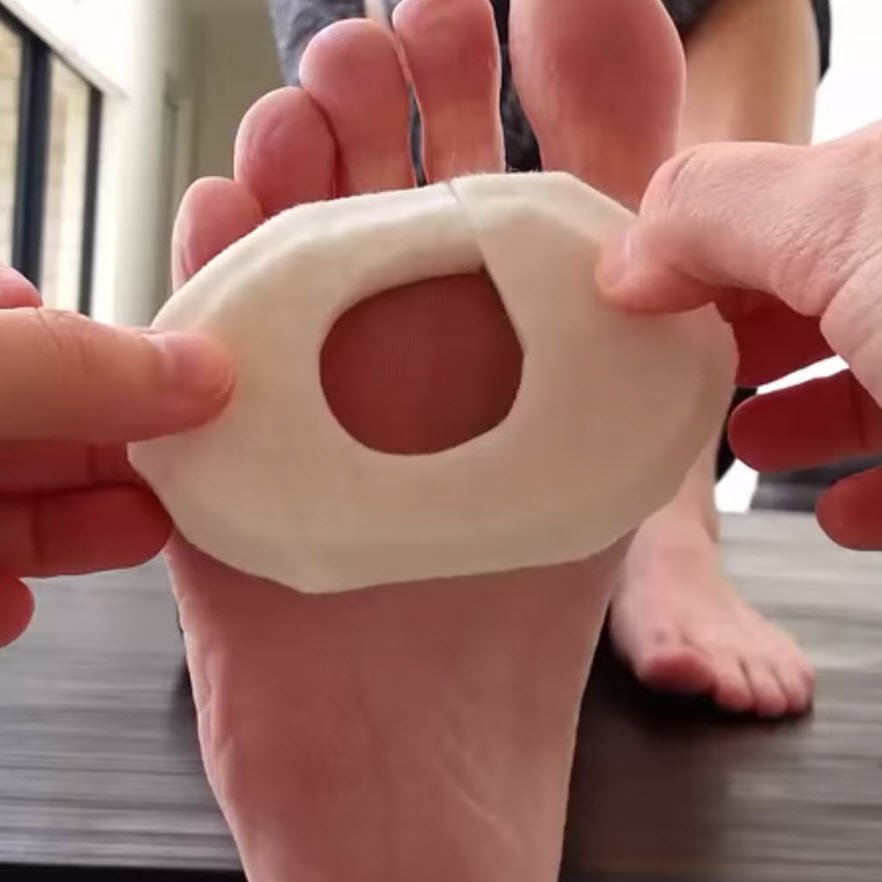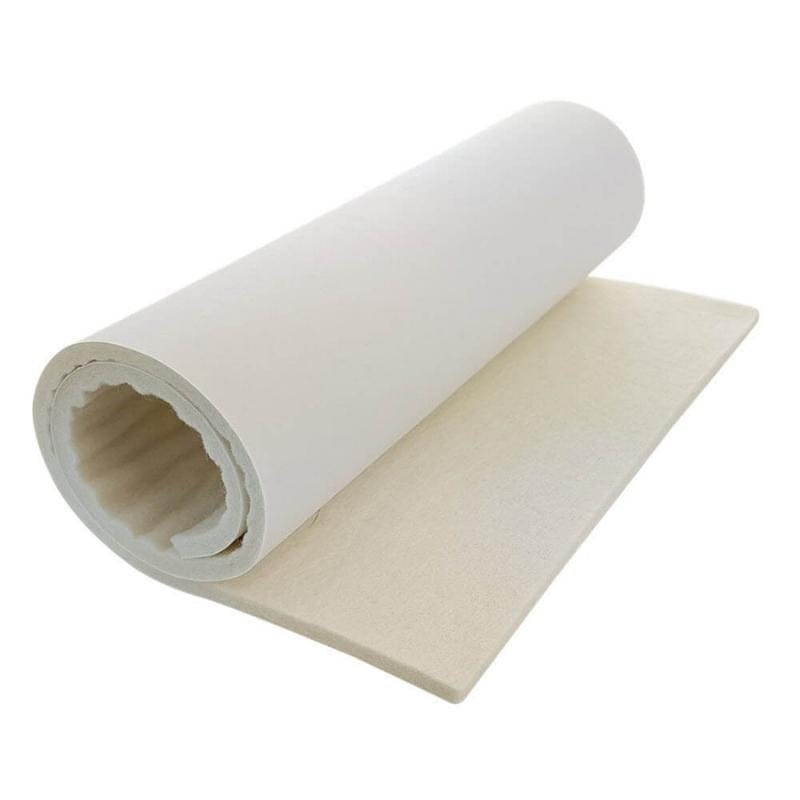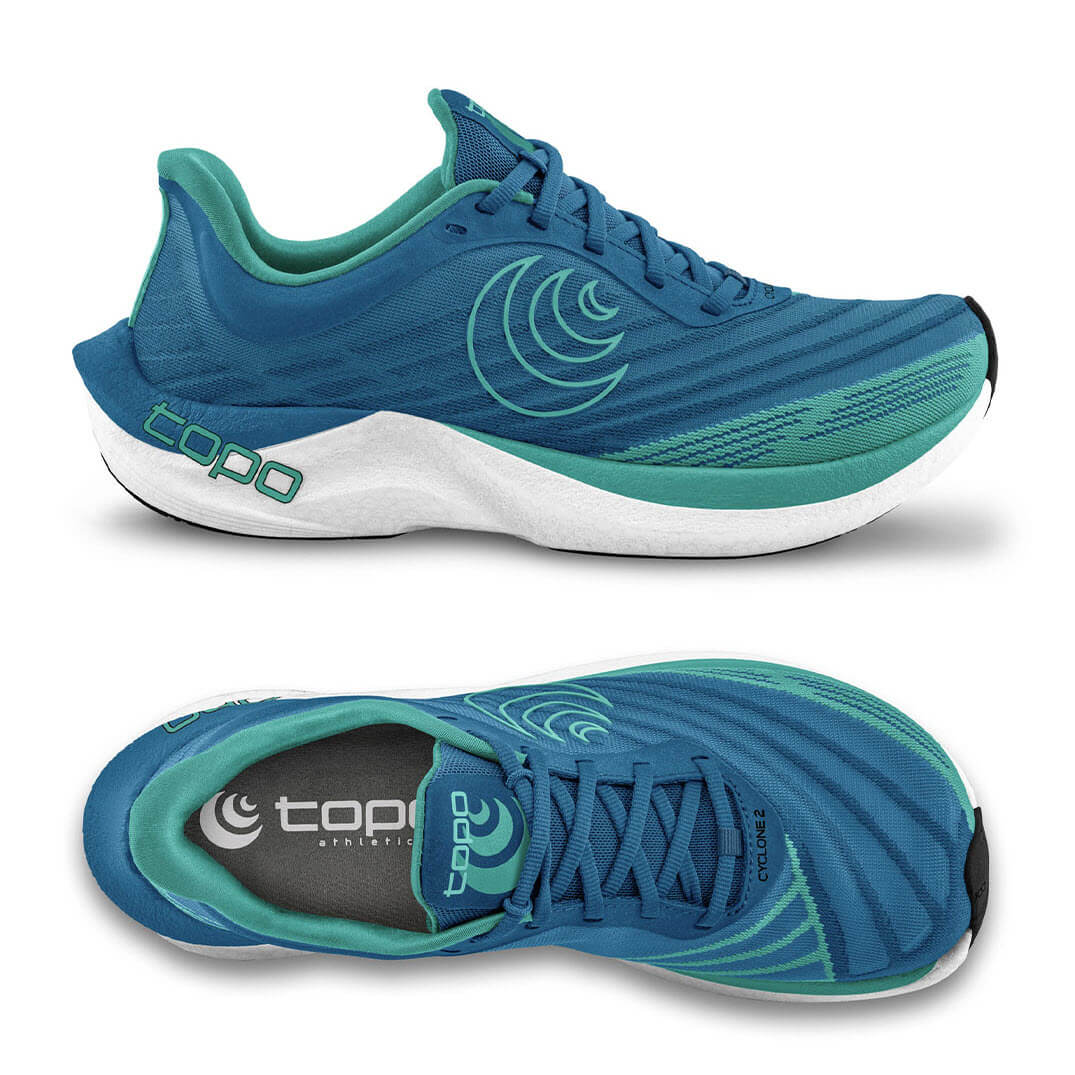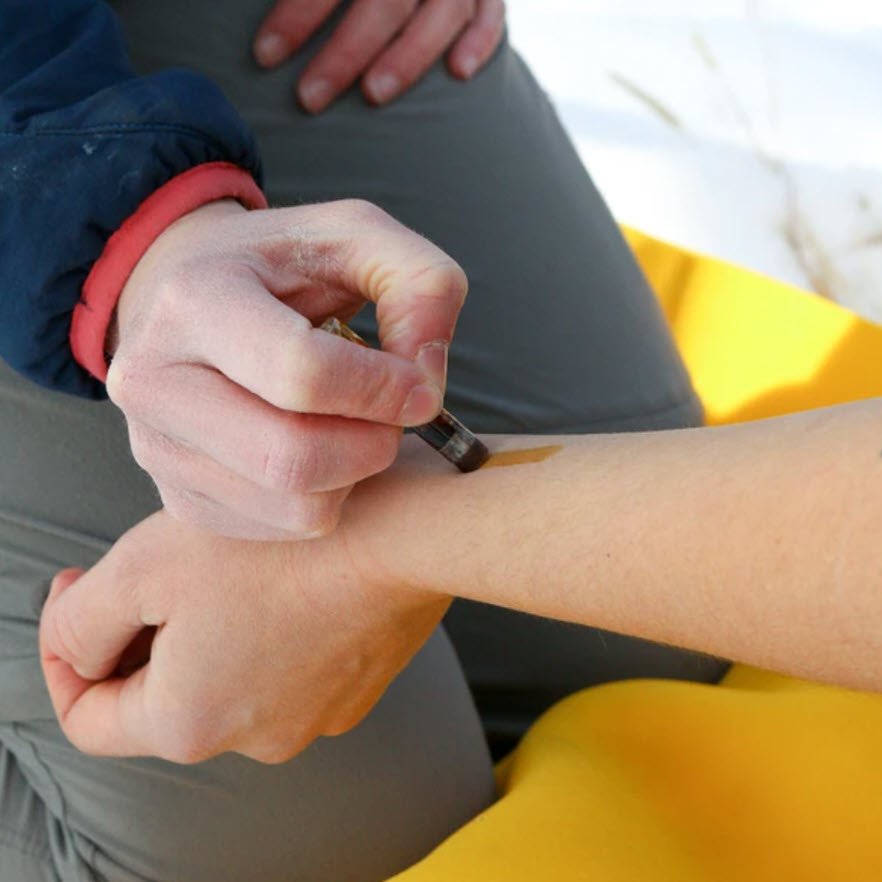Podiatrists often use donut pads (and their variations) to reduce pressure from painful areas and damaged skin – a blister, corn, callous, ulcer, swelling, inflammation, bursitis, nerve compression, bone bruise or stress fracture. These pressure-deflective paddings have to substantially lower tissue stress and provide real pain relief – often for days at a time. We use these paddings just about every day, so it’s fair to say we have a certain amount of expertise in how to use them to best effect.
In my last post, we discussed all the ins and outs of moleskin. Moleskin is an approx. 2mm thick cotton material. It’s common practice to cut a hole in a piece of moleskin and position that over your blister, like the picture below. It’s a common blister treatment practice I’m sure you’ve heard of even if you haven’t done it yourself.
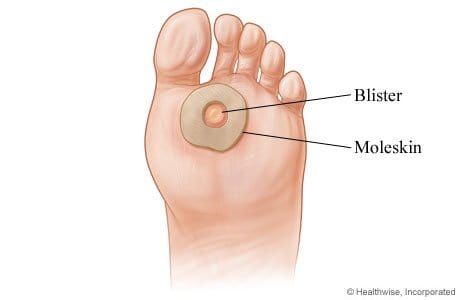
Moleskin donut pad under the ball of the foot
Here’s what I can tell you… podiatrists virtually never use moleskin to deflect pressure. And the donut pads we use would never be this small, at least not for this part of the foot.
Podiatrists make donut pads for blisters and all sorts of pressure problems like this (below). They’re much bigger and much thicker.
Why? The answer is, because it works better. And there’s no reason why you can’t treat your blisters to the benefits of these podiatry materials and techniques. So, let’s talk about donut pad shapes, width, thickness and materials.
The Shapes of Donut Pads for Blisters
A donut pad is essentially a pad with a hole in the middle of it. That hole will be slightly larger than the area you are looking to reduce pressure from.
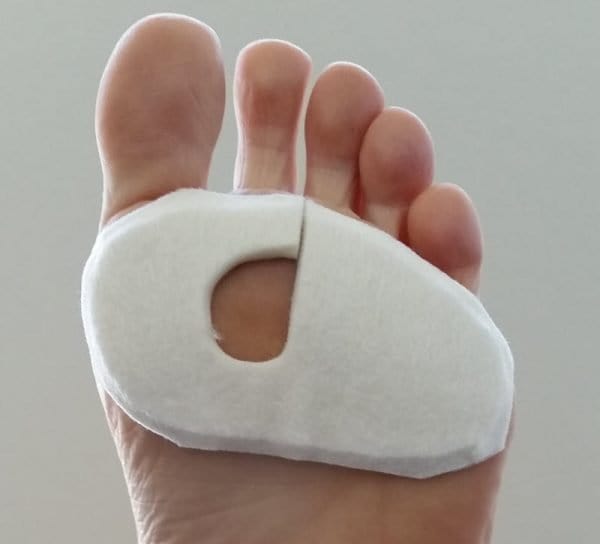
Donut pad made from 7mm felt
There are modifications to this basic shape - variations to the classic donut pads for blisters. For example, “U-shaped” pads are commonly used by podiatrists, especially where the sore area is near the edge of the foot.
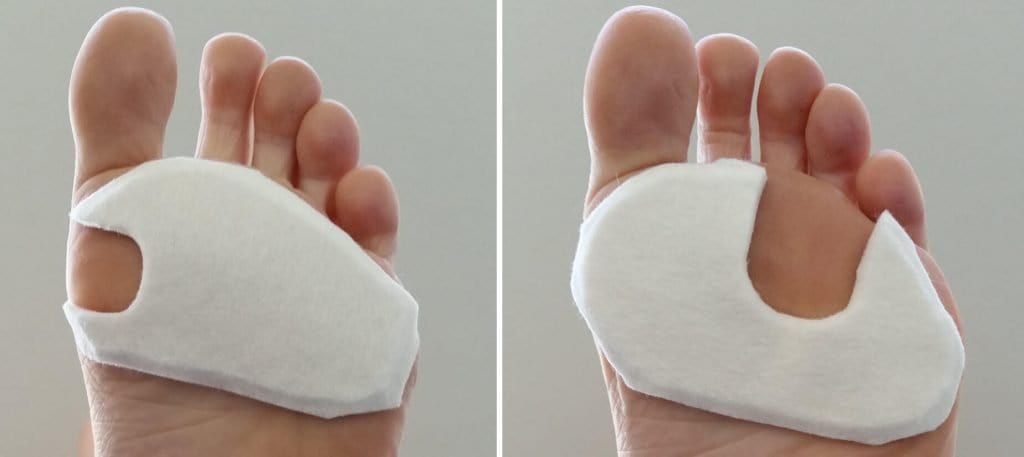
Modified donut pads made from 7mm felt to deflect pressure
Why So Wide?
Pressure = Force / Area
When you take pressure from one area, you increase it somewhere else. This is inevitable. Podiatrists are well aware of this, so when we take pressure from a painful area, we want to spread that extra pressure out over a large area. In this way, the increase per unit area is kept to a minimum. The larger the pad, the more comfortable it is.
Why So Thick?
The thicker the pad, the more pressure it will reduce.
However, donut pads and modified donut pads might not reduce pressure as much as you think. Here’s what research has shown:
- 5mm felt reduced pressure by between 24-31% (Neito-Gil et al, 2019).
- One study unsurprisingly confirmed that 7mm felt works better than 5mm at reducing pressure (Curren et al, 2015).
- Another found that 7mm felt modified donut pad was found to reduce pressure by 25% (Paton et al, 2007).
- A separate study, testing an extreme donut felt padding arrangement used for diabetic foot ulcers with a 20mm felt donut pad, found pressure was reduced by 49% (Raspovic et al, 2016).
So imagine how much pressure a 2mm moleskin donut pad is going to remove – not much!
If Not Moleskin, Then What?
Podiatrists most commonly use a self-adhesive semi-compressed felt (“felt” for short) to make their donut pads for blisters, corns and all the things we want to deflect pressure from. Felt is made from wool, or a wool and viscose mixture and is adhesive on one side.
Why semi-compressed? The compressed state of the fibres is responsible for the pressure deflection capabilities and comfort of the felt. We need a material that isn’t going to compress significantly to weightbearing pressure. At the same time, it needs to be comfortable to wear on your foot for days at a time. A good semi-compressed felt, like my favourite brand Hapla from Cuxson Gerrard in the UK, compresses up to 20% of its original thickness (Michael Ratcliffe, personal communication). This is the happy medium between effectiveness, longevity and comfort.
Hapla has a range of off-loading materials. The screenshot below shows their range. I use the 3rd semi-compressed felt in the image below (Hapla Mixture Felt). In fact, this is a common weapon of choice for podiatrists. It comes in 3mm, 5mm, 7mm and 10mm thicknesses and they are all self-adhesive. Moreover, the adhesive is very easy to get along with. I find with cheaper alternatives you’ll spend 3 minutes trying to get the paper backing off the felt. I don’t have time for that nonsense! So, over the last 27 years I’ve tried a few felts, but I keep coming back to Hapla. In fact, we have the 5mm Hapla felt in our online store for your convenience.
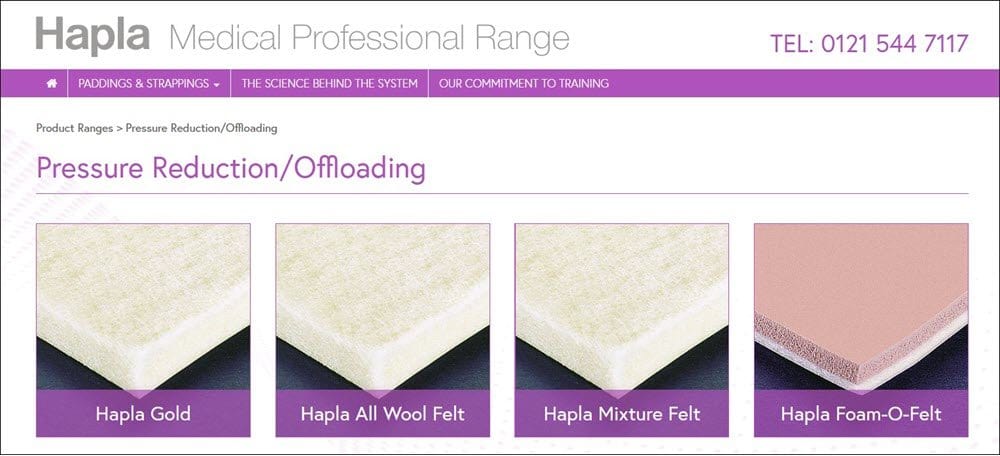
The Hapla deflective padding range
DIY Donut Pad Techniques
Here’s an excerpt from one of my videos showing the technique I commonly use to make donut pads (and a few extra felt pads).
Being in Australia, I get my Hapla felt from Briggate Medical. Here are two tutorials for felt pressure deflection from a Briggate catalogue that show the techniques very well.
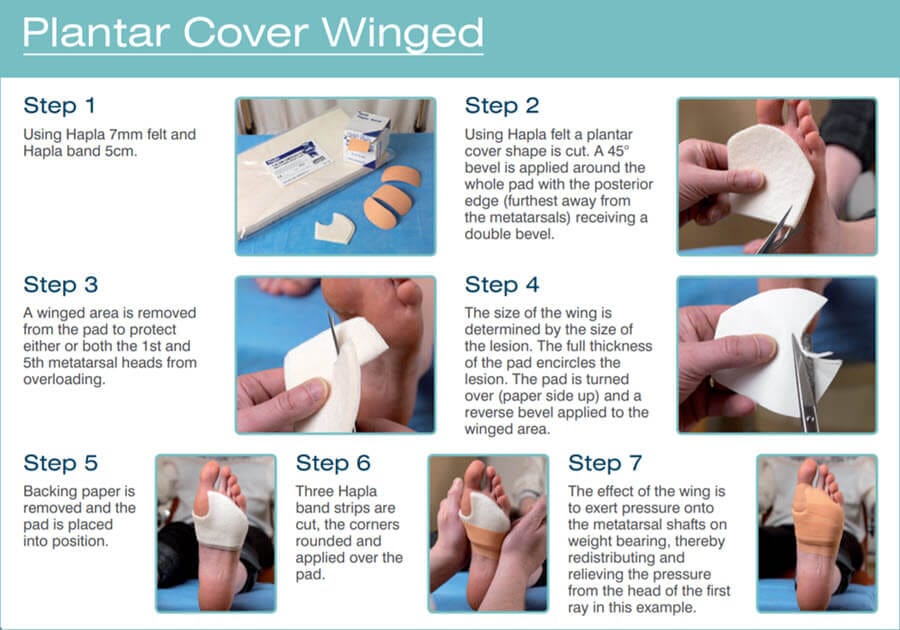
Deflective felt padding techniques
Want to learn more about the history of felt and how it's been used by podiatrists? My learned colleague Cameron Kippen will enlighten you with these two articles:
Best Practices For Making Felt Donut Pads
Bevel: Bevel the edges of your felt. The last thing you need is to feel a lumpy edge of felt and have that cause more problems than it fixes. Bevelling, as demonstrated in the picture below, is simply a process of turning your scissors on a 45 degree angle to thin the outer edges.
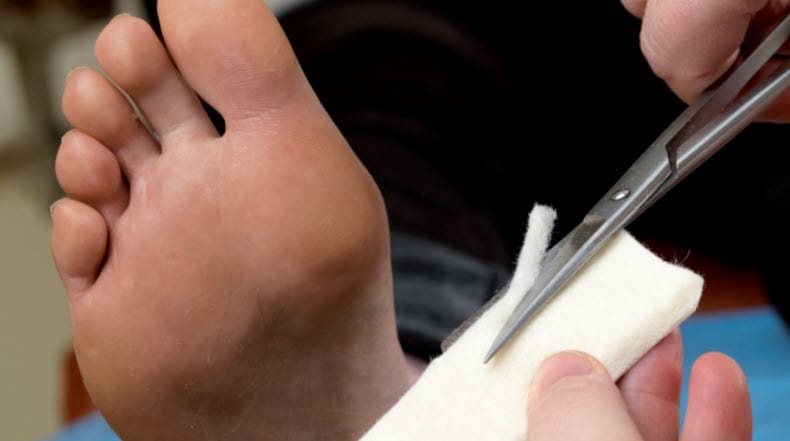
The technique of bevelling – holding scissors and cutting on a 45 degree angle
Fixation: Always secure the felt donut pad to your foot with a fixation tape,
something like Fixomull Stretch (or Hapla Band used in the above tutorials). It’s very easy to catch the edge of your felt pad as you put your sock on and have it bunch up and become an irritant - the fixation tape will prevent that. It will also help hold the pad on while you skin perspires.
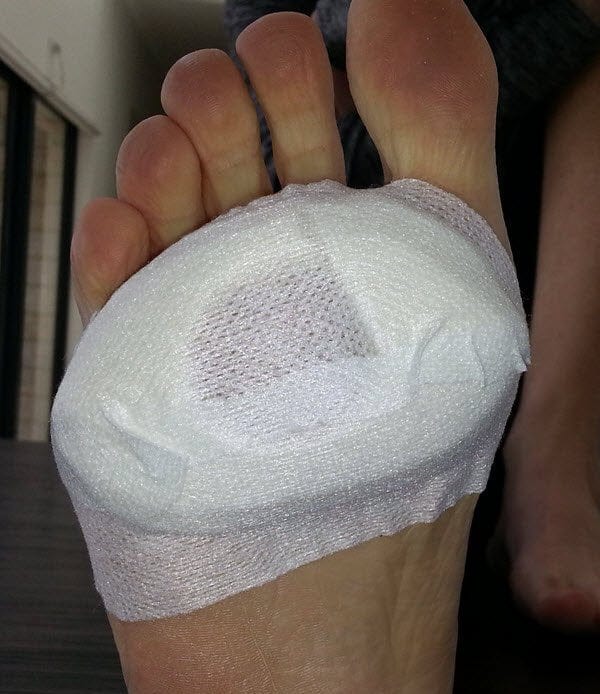
Fixomull Stretch fixation of a 7mm felt donut pad
Downsides of Donut Pads
There are a few things you need to be aware of when you use donut pads.
- As mentioned previously, they work by taking pressure of one area. But you will inevitably be increasing pressure where the pad is. Remember, the larger the surface area of your pad, the less you’re increasing pressure per unit area. Bigger is better - more comfortable.
- Not just any material will do. For example, open cell foams will compress too much and be ineffective. The thinner and more compressible the padding material, the less effective it will be. Thicker is better - more effective.
- Having just said bigger and thicker is better, donut pads take up room in your shoe. If space is tight, this might cause more problems than it fixes. It might increase pressure on a prominent bunion or flare up your Morton's neuroma, for example.
- There is a sharp increase in pressure at the periphery of the donut or cut-out. So, make sure your aperture is slightly bigger than your blister. To minimise the sharp increase in pressure, you can under-bevel the edge of the cavity – shown in the Briggate tutorials above.
- Felt compresses over time. Remember the study I mentioned about the 20mm felt donut pad used for diabetic ulcers? Initially, pressure was reduced by 49%, but that reduced to 32% after one week. Still pretty good, but the pressure reduction effect reduces with wear and it’s important to know that. At a guess, in a hiking or ultramarathon situation, a comparable amount of compression might occur in one day (compared to how much a diabetic with an ulcer is on their feet). If you need more, you can add another piece of felt over top of the original.
Other Limitations
- Using the ball of the foot as an example, if you’ve got a blister that takes up more than half the forefoot, a donut pad probably won’t work. It probably won’t reduce pressure enough to be beneficial, because you can’t redistribute that pressure to a large enough area. Or the pad might be uncomfortable as you’re having to increase pressure over a relatively small area.
- Using the tip of the toe as an example, donut pads won’t work here. Your blister will likely take up the whole toe tip – it’s not a very big area to start with. So there’s nowhere to fix a donut pad to. In this case, you’d make a felt toe-prop to straighten the toe and/or lift it up. Read this felt toe-prop case study for more details.
Long-Term or Preventive Deflective Donut Pads
If your blisters are so predictable that you’re using donut pads preventively, there are two longer-lasting options you can consider. These options will save you time, and money on supplies.
Felt Under Your Insole:
Why not stick the felt to the underside of your shoe’s insole, like I’ve done in the photo below. Podiatrists do this all the time because in this way, every time you pull your shoe on, your donut pad is in place. You can change that insole into any shoe you’re wearing. And just add more felt as it compresses.
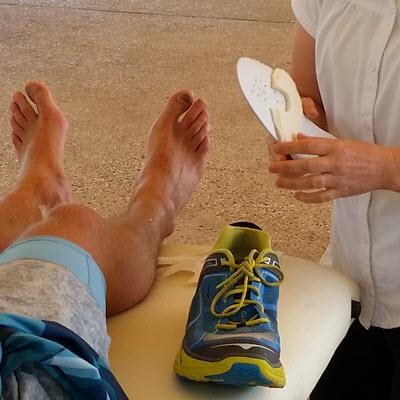
Felt modified donut pad places under the insole to deflect pressure
Use Poron Instead of Felt:
Use a material more durable than felt, something like Poron/PPT. Poron lasts much, much longer than felt because it doesn’t bottom-out. When it compresses to weightbearing pressure, it just bounces back to its original thickness, day in and day out. Podiatrists make insoles with Poron/PPT deflection a lot, so if you don’t have the materials or not sure how to do it, see a podiatrist.Conclusion
Donut pads have an important role to play in blister treatment. I use them on the runners I treat in race situations to great effect. This article has outlined the materials, shapes, and advanced techniques you can use to get the most from donut pads for blister specifically. Remember though, pressure-reduction is just one way to relieve blisters. You can read more about all the ways to implement blister prevention and pain-relief here.References
- Nieto-Gil, MP, Ortega-Avila, AB, Pardo-Rios, M, & Gijon-Nogueron, G. (2019). Effectiveness and Duration of Plantar Pressure Off-loading by Two Designs of Felt Padding: A Preliminary Study. Journal of the American Podiatric Medical Association. 109(6), 431–436.
- Curran, MJ, Ratcliffe, C, & Campbell, J. (2015). A comparison of types and thicknesses of adhesive felt padding in the reduction of peak plantar pressure of the foot: a case report. Journal of Medical Case Reports, 9, 203.
- Raspovic, A., Waller, K., & Wong, W. M. (2016). The effectiveness of felt padding for offloading diabetes-related foot ulcers, at baseline and after one week of wear. Diabetes Research and Clinical Practice, 121, 166–172.
- Paton, J., Woodrow, T., & Passmore, C. (2007). The effect of plantar cover padding with U'd cut-out on plantar foot pressure; a preliminary study.
- Briggate Medical. Podiatrists’ Guide To Hapla Padding & Strapping. Page 7.
- Michael Ratcliffe - Cuxson Gerrard (personal communication), May 2020.
- Cuxson Gerrard / Hapla. UK. Retrieved from cuxsongerrard.com and hapla.co.uk
- Kippen C. 2020 Foottalk Blog. Retrieved from https://foottalk.blogspot.com/
- Rushton, RJ. 2020. Exploring the Mechanism for Blister Prevention Using Moleskin. Current Sports Medicine Reports: Volume 19, Issue 11, p 451-453
